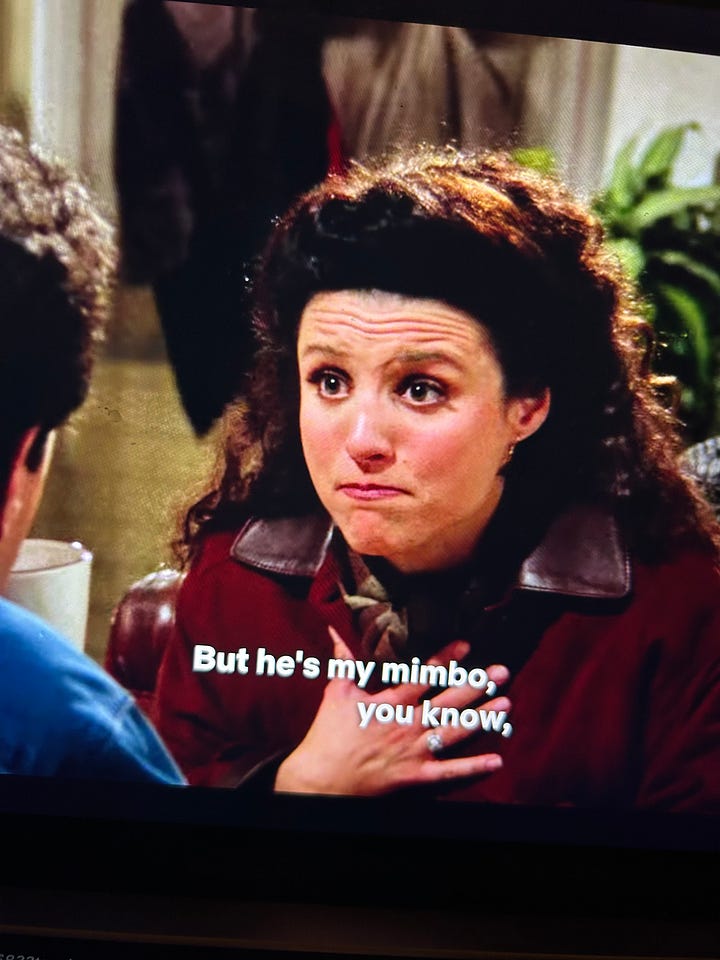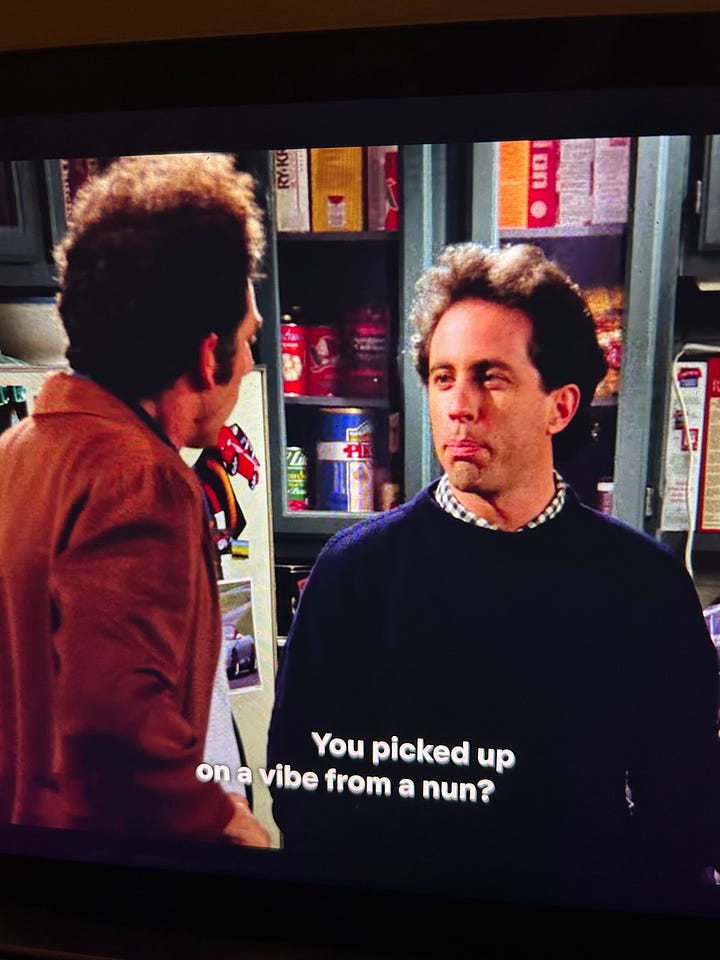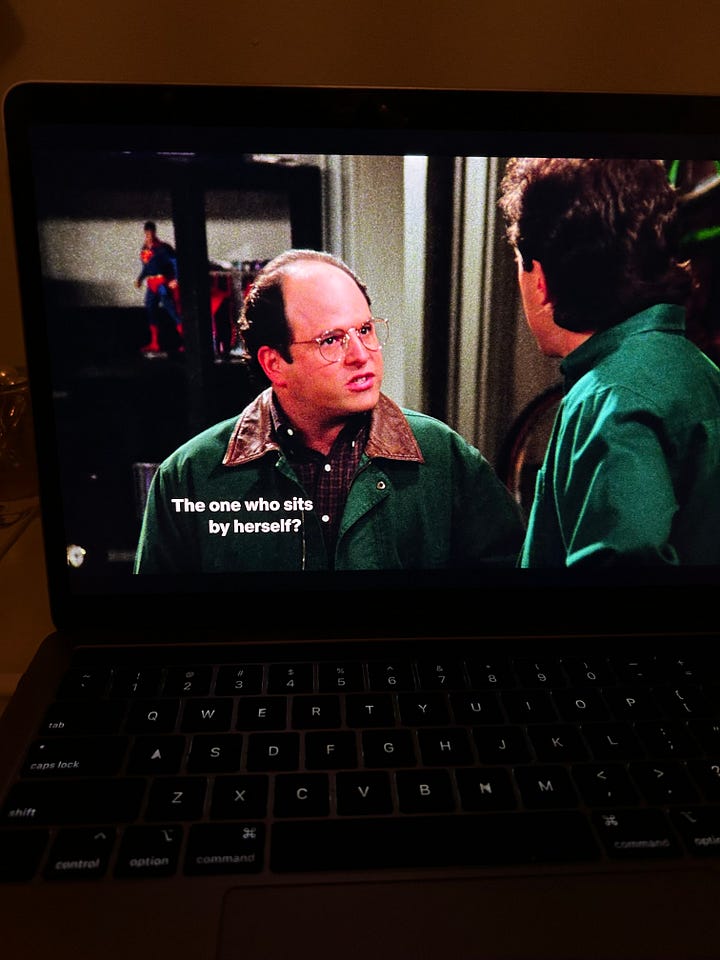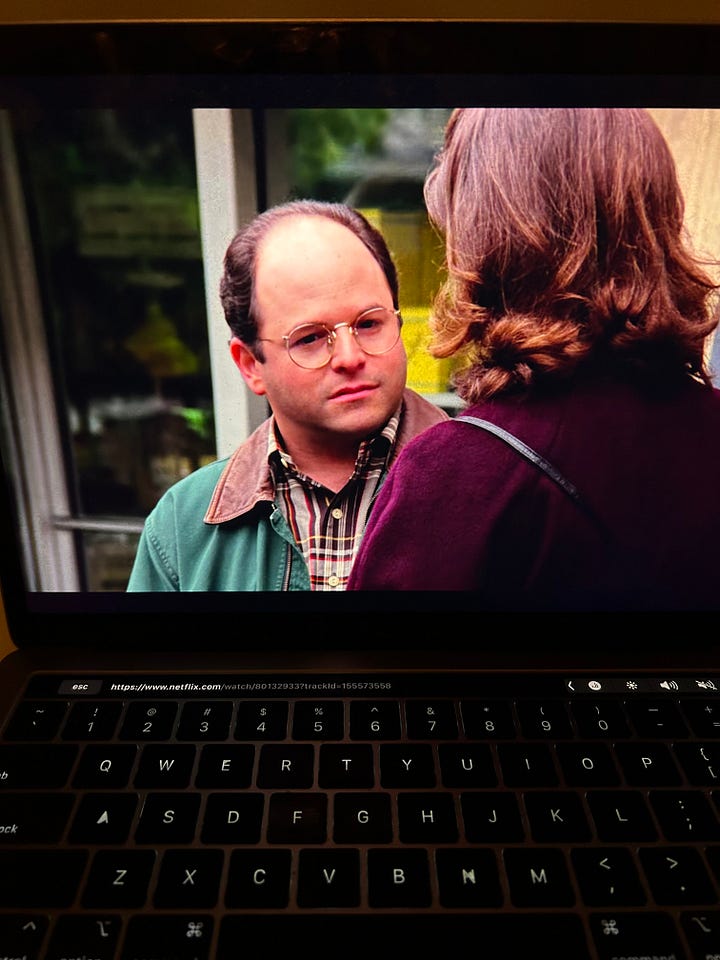seinfeld: a reflection, part i
Watching a “show about nothing” and searching for style inspiration suddenly leads to a revelation about myself that I’m still processing.
Last fall, I fell in love, though not with a person but rather a show.
When I started watching Seinfeld over the Labor Day long weekend, I wasn’t expecting to fall in love. I wasn’t expecting to fall in love because I went into the show with almost zero context and no expectations.
I knew that it was supposedly “a show about nothing” and that there were four main characters who I thought of abstractly as: that Bee Movie guy, Veep, Lionel from the 1997 Brandy-Whitney Houston Cinderella movie, and a crazy-haired man. What little I did know about the actual show was distilled into two fragments: someone dies from licking envelopes and Julia Louis-Dreyfus’ character dances erratically. That was literally it.
My love affair started because earlier last year, I started watching Curb Your Enthusiasm.
Mild spoilers ahead
It was the last show Jake and I watched as a married couple. We made it to the sixth season - the one where Cheryl and Larry split - before deciding to part ways ourselves. One could say it was life imitating art.
In the early days of our initial separation, still unsure how to navigate living together while we searched for our own apartments, we found ourselves gravitating to the couch after dinner. As Larry tries to win Cheryl back, we both looked at each other at different points as if to say, “Don’t get any ideas.”
When I finally settled into my new place and started the seventh season - alone - I felt confused.
Much of that season’s plot revolves around Larry still trying to get Cheryl back, but this time through a multi-episode plot around a Seinfeld reunion. The thing was, none of the jokes were landing and I quickly lost interest.
I moved on to other shows - Yellowjackets, a long-overdue Arrested Development re-watch - but if there’s one thing you should know about me, it’s that I’m a completionist. I knew I would have to return to Curb eventually, but I didn’t want to trudge through a few episodes to simply get it over with and move on to the next season.
I wanted to fully experience and appreciate the Curb season, which meant I had to go straight to the source.
Seinfeld isn’t a show about nothing - at least if you’re watching it through the lens of media and culture today. It’s a show about four friends in their thirties living in New York during the nineties. There’s Jerry, playing a warped version of himself as a rising stand-up comedian; his ex-girlfriend turned friend (and sometimes fuck buddy - but only for the laughs), Elaine; a hipster doofus neighbor called (Cosmo) Kramer; and the tightly wound, snorting George.
They go on dates, hang out over coffee or in apartments, travel together, and recap strange moments from their adventures throughout New York. Not unlike my life today, some thirty years later, or many of the shows people love now, but when Seinfeld first started airing in 1989 it was unlike anything people had seen before.
Most of the sitcoms at the time had a fairly reliable format. You might still have a group of friends, like Cheers, but shows of that era were still largely grounded in themes and characters from a more traditional time. Characters were in pursuit of money and relationships. They had families. They were largely “good” people. On the occasion they did err, often through a ‘very special episode,’ mistakes were swiftly addressed and resolved by the end of the episode.
Seinfeld was none of those things.
In fact, the show’s unofficial motto was ‘no hugging, no learning.’ Each character is flawed, but the show isn’t concerned about their redemption. Part of the humor rests in how each of the characters reflects our best and worst traits taken to their extremes. The show was able to capture the minutiae of life - seeing a friend’s new baby for the first time, buying an expensive gift for your parents, making an awkward faux pas at a dinner party - and brought them to life in ways so absurd that, aside from some dated technology, I found that much of it still holds up.
I didn’t set out watching this show to write an essay. Yet here we are, four months later, my life completely altered and forever changed.
What started in a Toronto hotel room quickly turned into a viewing experience that has potentially changed my life. Watching the show helped me think about what was - and might still be - possible on television. It made me think about storytelling and comedy writing in ways I had never fully considered.
More importantly, it helped me articulate something I have always felt but never knew how to express.
It made me realize I am a visual storyteller. That I want to explore and lean into those parts of myself more rather than continue to run from it.
What I’m trying to say is: Seinfeld made me re-think what I want to do in life, and it all started by noticing the…
COSTUMING
I’m still finding my personal style, but one of the ways I’ve tried to figure out what I like is by simply noting what other people are wearing - whether that’s out on the street, scrolling through TikTok, or other media I consume.
Most of the time that’s meant saving random images to Pinterest, but around season five, I started taking quick photos of different outfits that I liked.


Looking back at the photos for inspiration as I was online shopping or at a thrift store made me realize that the outfits the actors were wearing weren’t just random, but were carefully chosen because I quickly noticed: 1) they were often primary colors; and 2) those colors were compositionally balanced based on any given frame within a scene.
As an art history minor in college, my eye naturally looks at things like color, balance, and scale when I’m at a museum, but I had never considered the use of colors and costuming as a way to enhance a story. When watching other shows or movies, I would rarely pay attention to the costumes and lacked the visual data to draw those comparisons. That is, until Seinfeld.
Once I realized something bigger was going on, I suddenly needed to know everything about how and why certain colors were used in the show.
Many of the show’s now iconic outfits, including the puffy shirt, were in large part thanks to the show’s costume designer, Charmaine Simmons. A twenty-two-minute episode might have as many as fifty scenes, which meant Simmons needed to stay organized and get creative, while also paying attention to the script.
“If it’s a scene where [Elaine] is supposed to be angry, I’ll pick a red jacket to help create the mood. Or if Jerry has a date, I’ll give him a blue shirt to give him that sincerity.” - Charmaine Simmons (source)


Simmons, who grew up in Southern California, honed her skills by shopping in thrift stores and would have definitely been a Depop girly today.
Seinfeld was the biggest show at the time, so naturally, it had an impact on fashion. An article in the LA Times - as part of the larger retrospective craze leading up to the series finale; a craze so large there was, at one point, a helicopter positioned above the studio to capture glimpses of the cast and crew during the final taping - even went so far as to look at how each character’s style had evolved and offered some pithy one-liners.
Jerry: Boyish, generic sportswear topped with yummy leather and suede jackets.
Elaine: Manhattan somber, hip, but never what you’d call sexy.
Kramer: Goofy vintage.
George: Straight and serviceable.
Kramer’s “goofy vintage,” defined by his iconic loose rayon or silk patterned shirts, was such an inspiration in men’s fashion at the time that Simmons struggled to source outfits later in the show’s run.
The trouble is, when we started, we could buy his clothes in thrift shops or antique clothing stores. Now everybody wants to dress like him, and that Fifties and Sixties stuff is really hard to get. Fashion-wise, we've really created a monster. - Charmaine Simmons (source)
The show’s influence is still going strong. Amanda Mull even went so far as to describe 2023 as “the summer of Kramercore.”
Living in Brooklyn, I would agree.
While mainstream fashion is currently having a bit of a crisis - whether that’s about nonexistent trend cycles or the environmental impacts of micro-trends - from my observations, Brooklyn indie culture is currently drawing inspiration from fashion thirty and fifty years ago. This would place us not only squarely in the middle of Seinfeld’s run, but also the tail-end of Kramer’s then-vintage wardrobe too.
Case in point: while at Gertrude’s in Prospect Heights last fall, I asked one of the servers where he got his jeans. Without missing a beat, he said eBay and mentioned they were “actually from the 70s.” When I asked my (“not-into-fashion”) fashionable friend, Truman, about the pair the guy mentioned, he nodded and said eBay was the way to go for older vintage.
As I started paying more attention to the costuming, pretty soon I found myself jotting down notes to see how a character’s costume reinforced a scene or a joke. That quickly turned into noticing some of the show’s smaller quirks, like Jerry’s refrigerator decor changing each season, and then how an episode was fundamentally structured, how character stories diverged or intersected.
I didn’t realize what I was doing at the time, but I was starting to learn how to analyze a script. I was starting to think like a screenwriter and director.
This is getting a tad long, and I still have so much to say, so I’ve decided to break down this reflection into two additional posts!
Next Sunday, I’ll talk about Seinfeld’s writing and directorial approach, which has gone on to influence some of my other favorite shows, like 30 Rock, Girls, and even Atlanta. The final part will talk about the broader social and cultural influence of the show.
Until then, stay safe, have a good Martin Luther King Day, and see you on Friday for a shorter reflection!
xx Kayla




